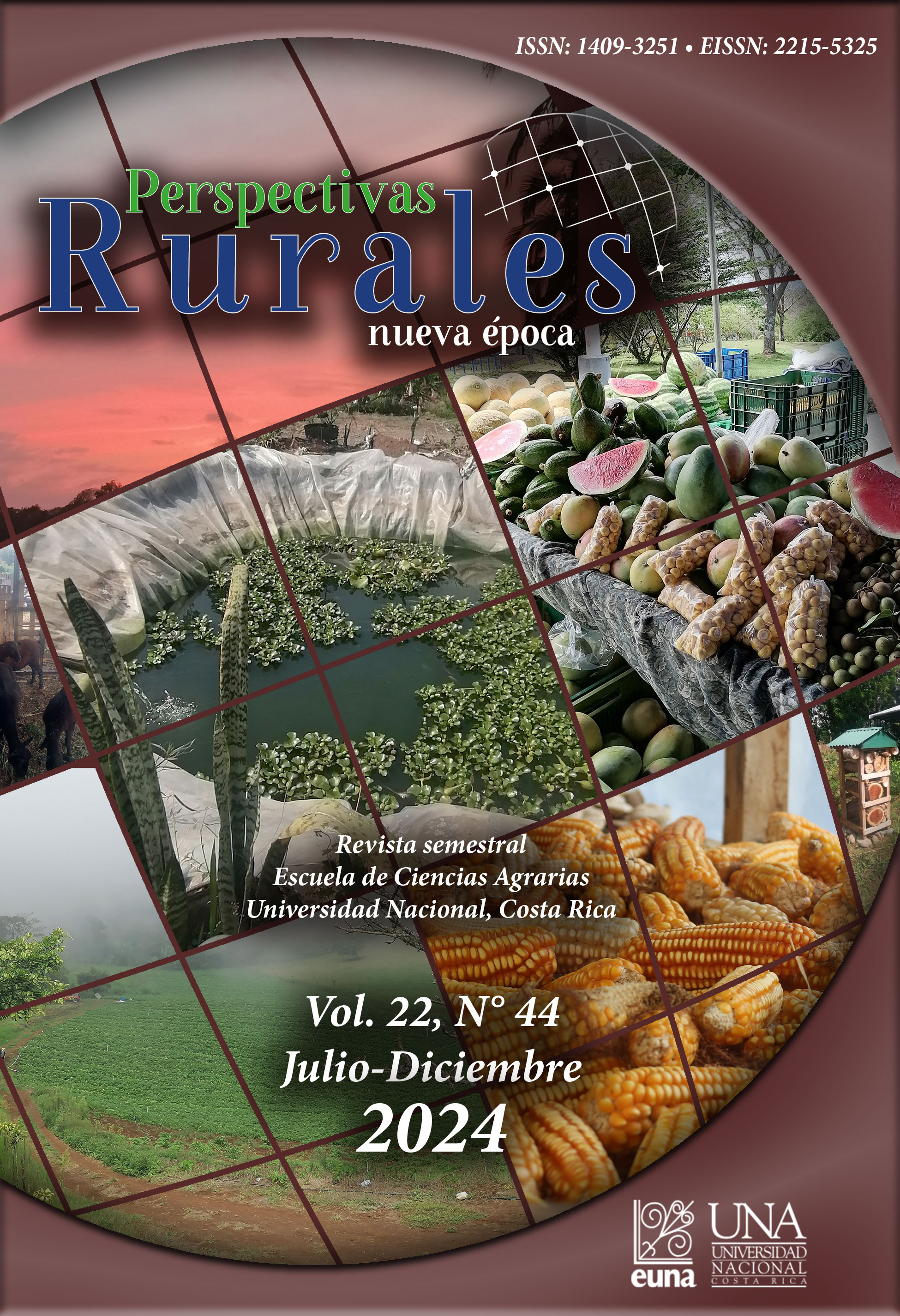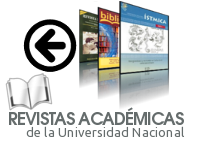Rust (Hemileia vastatrix) response to climatic conditions and fungicide applications in shade-grown coffee (Coffea arabica)
DOI:
https://doi.org/10.15359/prne.22-44.8Keywords:
coffee, plant disease, fungus, agriculture, agroclimatologyAbstract
Coffee leaf rust (Hemileia vastatrix) was first reported in 1869 on a plantation on the island of Sri Lanka, Asia, and has since spread to all coffee-growing regions far from its center of origin. The coexistence between the coffee plant, primarily Coffea arabica, and the fungus Hemileia vastatrix leads to coevolution, which manifests in significant genetic variability in the plant’s resistance to the disease and the fungus’s virulence towards the plant (Avelino and Rivas, 2013). The trophic relationships between the fungus and the host are influenced by soil moisture, fruit load, genetic resistance, precipitation, relative humidity, and temperature; these are the main factors affecting plant colonization (Filho and Astorga, 2015). In this study, the behavior of H. vastatrix was recorded through sampling to describe the relationship between disease incidence and environmental conditions, such as precipitation, temperature, and relative humidity, over an 18-month period at the Santa Lucía Experimental Farm (FESL) in Heredia, Costa Rica. The main findings demonstrated that the use of triazole fungicides and copper hydroxide can maintain disease incidence below 7%, despite contributions to its development from precipitation and increased temperatures, but not from increased relative humidity. Proper management of coffee leaf rust and the presence of shade can help reduce the incidence of the disease in the coffee plantation at FESL.
References
Agrios, G. N. (2008). Fitopatología. Editorial Limusa. https://infoagronomo.net/fitopatologia-gn-agrios-pdf/
Avelino, J. y Rivas, G. (2013). La roya anaranjada del cafeto. HAL (Le Centre pour la Communication Scientifique Directe). https://hal.archives-ouvertes.fr/hal-01071036
Avelino, J., Treminio, E., Casanoves, F., Vílchez, S., Cárdenas, J. y Lizardo, C. (2019). Guía para la vigilancia de la roya del café (Hemileia Vastatrix). CATIE eBooks. https://agritrop.cirad.fr/595182/
Barquero, M. (2013). Recomendaciones para el combate de la roya del cafeto. Instituto del Café de Costa Rica, 48.
Brenes, G. C., Víquez, C. S., Thomason, P. O., Ramírez, J. R., Hurtado, A. N., Morales, G. G. y Rodríguez, S. V. (2016). La situación y tendencias de la producción de café en América Latina y el Caribe. Instituto Interamericano de Cooperación Para la Agricultura (IICA).
Centro Nacional de Investigaciones de Café [Cenicafé]. (2009). Sombrío para el cultivo del café según la nubosidad de la región. https://www.cenicafe.org/es/publications/avt0379.pdf
Filho, E. y Astorga, C. (2015). Prevención y control de la roya del café. Manual de buenas prácticas para técnicos y facilitadores. En CATIE, Turrialba (Costa Rica). https://repositorio.catie.ac.cr/handle/11554/8186
Gestor. (31 de 10 de 2019). EL COBRE, UN FUNGICIDA HISTÓRICO. https://www.silosdelcinca.com/fungicida/cobre-fungicida-historico/
Gichuru, E., Ithiru, J. M., Silva, M. C., Pereira, A. P. y Várzea, V. (2012). Additional physiological races of coffee leaf rust (Hemileia vastatrix) identified in Kenya. Tropical Plant Pathology, 37(6), 424-427. https://doi.org/10.1590/s1982-56762012000600008
Granados Brenes, E. (2021). Evaluación de la Roya de café bajo sombra y estrategias de manejo. Universidad de Costa Rica, Sede del Atlántico.
IMN. (2022). Datos meteorológicos. https://www.imn.ac.cr/web/imn
FRAC [COMITÊ DE AÇÃO A RESISTÊNCIA A FUNGICIDAS]. (2019). Clasificación de fungicidas y bactericidas según el modo de acción. https://fmcagro.es/blog/ver-entrada/clasificaci%C3 %B3ndelosmodosdeacci%C3 %B3ndeFRACeIRAC
López Bravo, D., De Melo Virginio Filho, E. y Avelino, J. (2012). Shade is conducive to coffee rust as compared to full sun exposure under standardized fruit load conditions. Crop Protection, 38, 21-29. https://doi.org/10.1016/j.cropro.2012.03.011
McCook, S. (2009). La roya del café en Costa Rica: Epidemias, innovación y medioambiente, 1950-1995. Revista de História, 59, 99-117. https://dialnet.unirioja.es/servlet/articulo?codigo=6820121
Montes de Oca, P. y Mata, R. (2019). Clasificación de los suelos de la finca Experimental Santa Lucía. Ciencias Ambientales. https://doi.org/10.15359/rca.12-1.3
Rugeles Barrios, O. (11 de octubre de 2017). Triazoles, ¿Todos iguales? ¿Se deben mezclar? https://www.metroflorcolombia.com/triazoles-todos-iguales-se-deben-mezclar/
Treminio, E. (2019). Estimación de la eficiencia de métodos territoriales de muestreo de la roya del café (Hemileia vastatrix) en Honduras, El Salvador, Panamá y República Dominicana (Tesis Doctoral, CATIE).
Zamora Picado, F. (2015). Eficiencia en el combate de la roya del café (Hemileia vastatrix) con diferentes metodologías de aspersión para fungicidas. Escuela de Ciencias Agrarias, Universidad Nacional de Costa Rica.
Zamora Macorra, E. J., Zamora Macorra, M. y Elizalde Gaytan, K. G. (2020). Interacción entre Mycodiplosis y Hemileia vastatrix en tres escenarios de manejo del cultivo de café (Coffea arabica). Revista mexicana de fitopatología, 38(3), 3.
Published
How to Cite
Issue
Section
License
Copyright (c) 2024 Isidro Calero Ocón

This work is licensed under a Creative Commons Attribution-NonCommercial-NoDerivatives 4.0 International License.
![]()
Revista Perspectivas Rurales. Nueva Época se encuentra bajo una licencia Creative Commons Reconocimiento-NoComercial-CompartirIgual 4.0 Internacional License.
Creado a partir de la obra en http://www.revistas.una.ac.cr/index.php/perspectivasrurales
Los autores/as que publiquen en esta revista aceptan las siguientes condiciones:
- Los autores/as conservan los derechos de autor y ceden a la revista el derecho de la primera publicación, con el trabajo registrado con la Licencia Creative Commons Atribución-NoComercial-CompartirIgual 4.0 Internacional, que permite a terceros utilizar lo publicado siempre que mencionen la autoría del trabajo y a la primera publicación en esta revista.
- Los autores/as pueden realizar otros acuerdos contractuales independientes y adicionales para la distribución no exclusiva de la versión del artículo publicado en esta revista (p. ej., incluirlo en un repositorio institucional o publicarlo en un libro) siempre que indiquen claramente que el trabajo se publicó por primera vez en esta revista.
- Se permite y recomienda a los autores/as a publicar su trabajo en Internet (por ejemplo en páginas institucionales o personales) antes y durante el proceso de revisión y publicación, ya que puede conducir a intercambios productivos y a una mayor y más rápida difusión del trabajo publicado.






